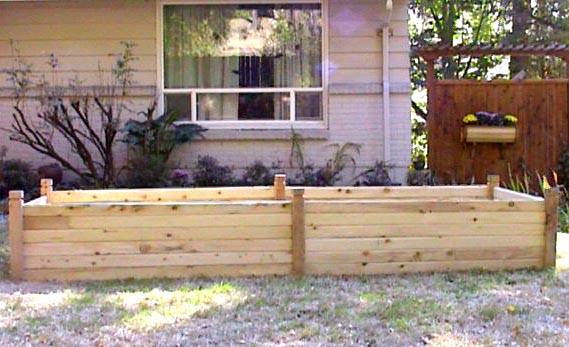

Willow raised beds
Cedar wood raised 12' long
Where soil is poor and drainage inadequate, Raised
beds make it easy to create areas of fertile, well-drained soil. They save
considerable time and money, too.
It's
cheaper than installing a drainage system and then trucking in topsoil. You also
can fill raised beds with a soil mixture that meets special needs. Coupled with
precise drainage control, you can grow rhododendrons, azaleas and other plants
that are fussy about their root environment.
Raised beds elevate plants to a convenient working level, making them easier to
tend and enjoy. They're great for vegetable or cutting gardens.
For
those who can't bend over or must garden from a wheelchair, raised beds are a
particularly good idea. Make sure the area between beds is wide enough and hard
enough for easy movement.
Raised beds are a boon in low-maintenance
schemes, too. They keep plants organized. They confine soil, dead leaves and
other debris within their borders. And they reduce the work of cleaning the
yard. Weed control made easy, just make sure you cover the area where you are
going to build the bed with a layer of black plastic landscape fabric and make
sure you punch a few holes to help trainage.
Many
attractive landscape designs use raised beds, separated by expanses of detailed
paving, to reduce maintenance. These designs can enhance your home and garden
and give you the time you need to enjoy both. Raised bed can be constructed with
materials that are strong enough to hold the content of the bed,
cedar wood,
bamboo and even willow make attractive
raised bed.
By
having permanent bed structures, decorations such as trellises and fences can be
permanently installed, too. This allows you to build them of durable materials
such as cedar, cypress or redwood.
There are many reasons for the Raised beds revival. But probably the most
important is more production per square foot of garden. Raised beds don't
require the usual space between rows because you don't walk in the bed to
cultivate or harvest.
Another reason for greater production is improved soil conditions. Soil
compaction can reduce crop yields up to 50 percent. Water, air and roots all
have difficulty moving through soil compressed by tractors, tillers or human
feet.
Plows, tillers or spades are the usual answers to this problem. But gardeners
can avoid the problem by creating beds narrow enough to work from the sides.
Organic matter can be increased greatly without getting bogged down, because
raised beds drain better.
Raised beds also help when compaction isn't the only culprit. Homeowners may
have low spots unsuited for conventional gardens because of ponding or excessive
erosion from runoff. Raised beds rise above these, with frames as a foundation.
Gravity becomes an ally, not only in avoiding soggy soils but in using a problem
area. We have exclusively design a rooftop
raised bed for city urban gardening and greening your rooftop, rooftop
raised bed cost a lot less than the traditional full scale green roof which
involved with the structural evaluation and extensive construction of growing
medium.
The
gardener shares some benefits from Raised beds as well. First, and most
important, is that timely planting and harvesting are easier. Most people avoid
working traditional gardens in rainy weather to avoid compaction and muddy feet.
But raised beds are designed for walking around, not in. So there's no reason
for mud to delay operation.
Spaces between beds may be left in sod, mulched or even paved with stone or
brick.
Pest
control becomes easier in raised beds, too. If burrowing rodents abound, line
the bottom of the bed with poultry wire or hardware cloth. Discourage rabbits
and groundhogs by placing their favorite foods in a framed bed with a low fence.
Beds' narrow dimensions even make it practical to suspend bird netting on
flexible conduit frames. You can control weeds with plastic mulch economically,
since the width of the bed can be spanned by one roll.
The
narrow beds help save water, too. Several watering systems ensure the water gets
only where it is needed. Canvas soaker hoses, perforated plastic sprinkle hoses
and drip-type irrigation disperse water in a long, narrow pattern well-suited to
beds.
These systems reduce diseases, too, by directing water to the soil instead of
wetting leaf surfaces as overhead irrigation does.

![]() Gardeners' Corner
Kids'
Garden
Sustainable Garden
Contact Us
Gardeners' Corner
Kids'
Garden
Sustainable Garden
Contact Us![]()




